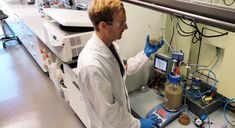Using bacteria to recover valuable metals from waste incineration residues
The natural supply of metals such as copper is limited, yet consumption is steadily increasing and supply shortages are looming due to global events. At the same time, waste incineration - the most common method of waste treatment in Austria - leaves valuable metals in the ash and slag as previously unused secondary raw materials. For every ton of incinerated residual waste, around 25% residual materials such as ash and slag are produced. The metals contained therein in quite high concentrations, such as copper, zinc and nickel, are lost as a result. Not only that, due to the high concentrations of heavy metals, these materials have to be disposed of separately and currently have no further use.
Awarded the "Science Future Prize 2022
Klemens Kremser, Postdoctoral Researcher at the Institute of Environmental Biotechnology at BOKU has developed a method in the context of his dissertation "Urban mining - Potential bioleaching applications for metal recovery from low grade artificial ores", in which extremely acidophilic (= acid resistant) bacteria dissolve metals in biological leaching in order to separate them from the waste materials. In this way, the metals contained are saved from disposal and can be returned to a material cycle. In addition, the bacteria reduce the heavy metal concentrations in the ashes and slags from waste incineration to such an extent that the materials could no longer be landfilled, but could be used, for example, in road or landfill construction. Kremser was recently awarded the "Science Future Prize" by the Society for Research Promotion of Lower Austria for his dissertation.
"Biological leaching using bacteria offers an inexpensive, environmentally friendly and effective alternative to conventional methods. As a result, economically important metals can be recovered as secondary raw materials from residual materials such as ashes and slags, and material cycles can be closed," Kremser explains. Conventional methods of metal extraction involve high energy input or the use of environmentally harmful chemicals such as cyanide or concentrated acids.
Partially higher concentration than in mining of natural deposits
Kremser examined ashes and slags from various industries such as waste incineration plants in Austria and the Czech Republic, as well as the steel industry in Austria. It was found that waste incineration residues in particular contain high concentrations of metals such as iron, copper, zinc, nickel, chromium and manganese. In the case of copper and zinc, the concentrations found were in some cases even higher than in naturally occurring minerals and developed mines, underscoring the importance of these waste materials as secondary sources of raw materials.
Biological leaching of these waste materials using different bacteria has shown that a combination of the bacteria studied is more effective in extracting metals than using pure cultures. Metals such as copper, zinc, manganese and nickel could be biologically leached and thus recovered up to 100%. In the future, the research conducted opens up further possibilities for investigating the biological leaching of ashes and slags on a larger scale. For this purpose, the operators of waste incineration plants are an obvious choice, since at these locations the necessary space, a simple and economical tempering of the processes via the process exhaust air, and short transport distances bring many advantages. Thus, implementation of biological leaching to treat the waste materials generated there would also be reasonable from an economic point of view.
The research was carried out within the Interreg project ATCZ183 "Innovative Recycling Strategies for Ashes and Slags - IRAS" at the Institute of Environmental Biotechnology of the University of Natural Resources and Life Sciences Vienna.
Scientific contact:
DI Dr. Klemens Kremser
Project Leader
Postdoctoral Researcher
-------------------------------------
Institute of Environmental Biotechnology
Department of Agrobiotechnology - IFA Tulln
BOKU - University of Natural Resources and Life Sciences, Vienna
Konrad-Lorenz-Strasse 20
A-3430 Tulln
Phone: +43 1 47654-97498
E-mail: klemens.kremser(at)boku.ac.at

